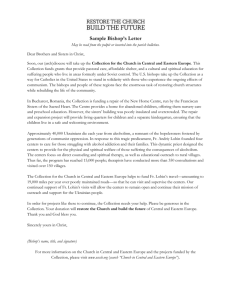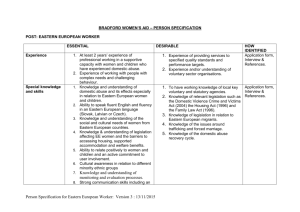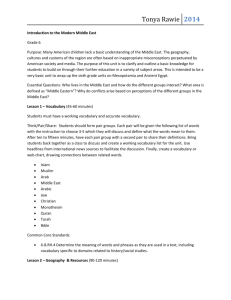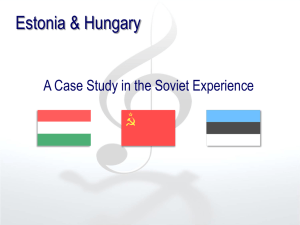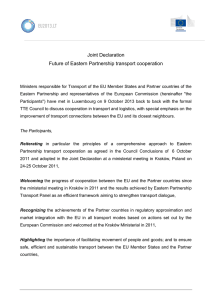ATA 655 Politics and Society in Eastern Europe
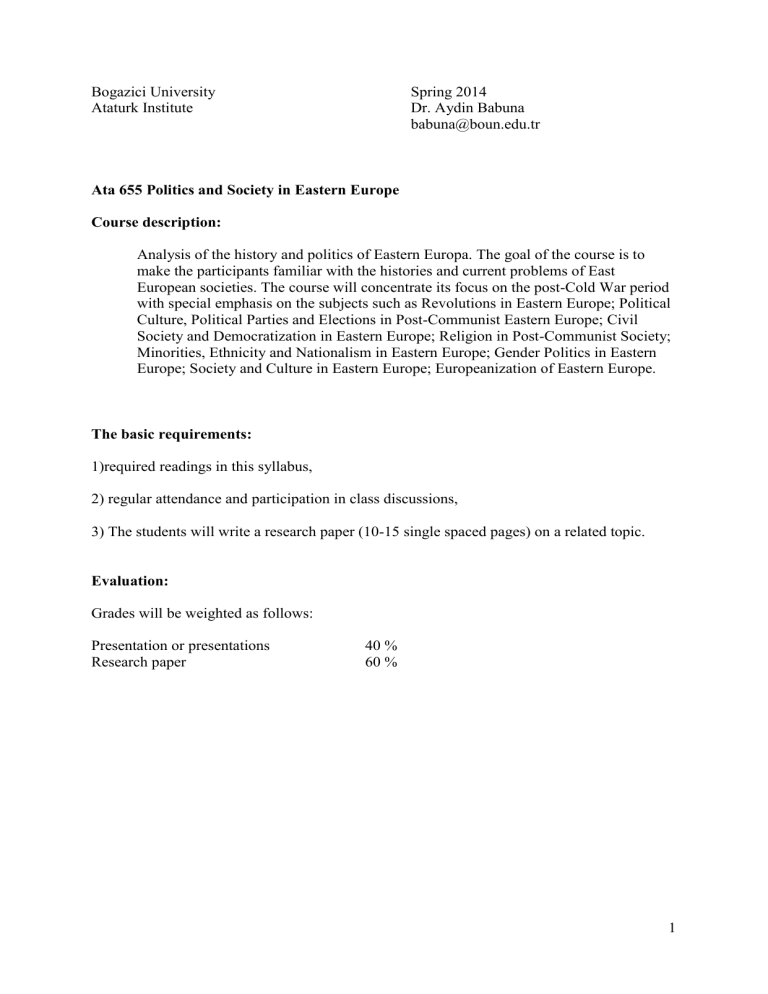
Bogazici University
Ataturk Institute
Spring 2014
Dr. Aydin Babuna babuna@boun.edu.tr
Ata 655 Politics and Society in Eastern Europe
Course description:
Analysis of the history and politics of Eastern Europa. The goal of the course is to make the participants familiar with the histories and current problems of East
European societies. The course will concentrate its focus on the post-Cold War period with special emphasis on the subjects such as Revolutions in Eastern Europe; Political
Culture, Political Parties and Elections in Post-Communist Eastern Europe; Civil
Society and Democratization in Eastern Europe; Religion in Post-Communist Society;
Minorities, Ethnicity and Nationalism in Eastern Europe; Gender Politics in Eastern
Europe; Society and Culture in Eastern Europe; Europeanization of Eastern Europe.
The basic requirements:
1)required readings in this syllabus,
2) regular attendance and participation in class discussions,
3) The students will write a research paper (10-15 single spaced pages) on a related topic.
Evaluation:
Grades will be weighted as follows:
Presentation or presentations
Research paper
40 %
60 %
1
1) Historical Background
Robin Okey, Eastern Europe 1740-1985. Feudalism to Communism (London: Hutchinson,
1986), pp 110-156.
Robert Brenner, “Economic Backwardness in Eastern Europe in Light of Developments in the
West,” in: Daniel Chirot (ed.), The Origins of Backwardness in Eastern Europe. Economics and Politics from the Middle Ages until the Early Twentieth Century (Berkeley: University of
California Press, 1989), pp. 15-52.
John R. Lampe, “Imperial Borderlands or Capitalist Periphery ? Redefining Balkan
Backwardness, 1520-1914,” in: Daniel Chirot (ed.), The Origins of Backwardness in Eastern
Europe. Economics and Politics from the Middle Ages until the Early Twentieth Century
(Berkeley: University of California Press, 1989), pp. 177-209.
2) Eastern Europe in the Inter-War Period
Robert Bideleux, Ian Jeffries (eds.), A History of Eastern Europe. Crisis and Change (London:
Routledge,1998), pp. 405-516.
3) Eastern Europe and Cold War
Jan Gross, “War as Revolution,” in Norman Naimark, Leonid Gibianskıı (eds.), The
Establishment of Communist Regimes in Eastern Europe (Boulder: Westview Press, 1997), pp 17-35.
Ivan T. Berend, Central and Eastern Europe 1944-1993. Detour from the Periphery to the
Periphery (New York: Cambridge University Press, 1996), pp. 182-253.
4) Revolutions in Eastern Europe
Ivan T. Berend, Central and Eastern Europe 1944-1993. Detour from the Periphery to the
Periphery (New York: Cambridge University Press, 1996), pp. 254-299.
Attila Agh, Emerging Democracies in East Central Europe and the Balkans (Cheltenham:
Studies of Communism in Transition, 1998), pp 113-140; 165-186.
5) Consumption and Daily Life in Cold War Eastern Europe
Pauline Bren, “Tuzex and the Hustler. Living it Up in Czechoslovakia,” in Paulina Bren,
Mary Neuburger(eds.), Communism Unwrapped (New York: Oxford University Press, 2012), pp. 29-48.
Mary Neuburger, “The Taste of Smoke. Bulgartabak and the Manufacturing of Cigarettes and
Satisfaction,” in Paulina Bren, Mary Neuburger (eds.), Communism Unwrapped (New York:
Oxford University Press), pp. 91-115.
2
Patrick Hyder Patterson, RiskyBusiness. What was Really Being Sold in the Department
Stores of Socialist Eastern Europe?” in Paulina Bren, Mary Neuburger (eds.), Communism
Unwrapped (New York: Oxford University Press, 2012), pp. 116-139.
Jill Massino, From Black Caviar to Blackouts. Gender, Consumption, and Lifestyle in
Ceaşescu’s Romania,” in Paulina Bren, Mary Neuburger (eds.), Communism Unwrapped
(New York: Oxford University Press, 2012), pp. 226-249.
Tamas Dombos and Lena Pellandini-Simanyi, “Kids, Cars, or Cashews ? Debating and
Remembering Consumption in Socialist Hungary,” in Paulina Bren, Mary Neuburger (eds.),
Communism Unwrapped (New York: Oxford University Press, 2012), pp. 325-350.
Brigitte Le Normand, “ The House that Socialism Built. Reform, Consumption, and
Inequality in Postwar Yugoslavia,” in Paulina Bren, Mary Neuburger (eds.), Communism
Unwrapped (New York: Oxford University Press, 2012), pp. 351-373.
6) Gender Politics in Eastern Europe
Ulf Brunnbauer, “The Most Natural Function of Woman”: Ambiguous Party Policies and
Female Experiences in Socialist Bulgaria,” in Shana Penn, Jill Massino (eds.), Gender Politics and Everyday Life in State Socialist Eastern and Central Europe (New York: Palgrave
McMillan, 2009), pp. 77-96.
Isabel Marcus, “ Wife Beating: Ideology and Practice under State Socialism in Hungary,
Poland and Romania,” in Shana Penn, Jill Massino (eds.), Gender Politics and Everyday Life in State Socialist Eastern and Central Europe (New York: Palgrave McMillan, 2009), pp. 115-
132.
Kimberly Elman Zarecor, “Designing for the Socialist Family: The Evolution of Housing
Types in Early Postwar Czechoslovakia,” in Shana Penn, Jill Massino (eds.), Gender Politics and Everyday Life in State Socialist Eastern and Central Europe (New York: Palgrave
McMillan, 2009), pp.151-168.
Ana Hofman, “ When we were Walking Down the Road and Singing”: Rural Women’s
Memories of Socialism in Serbia,” in Shana Penn, Jill Massino (eds.), Gender Politics and
Everyday Life in State Socialist Eastern and Central Europe (New York: Palgrave McMillan,
2009), pp.185-197.
Sharon L. Wolchik, “Women and the Politics of Gender in Communist and Post-Communist
Central and Eastern Europe,” in: Sabrina P. Ramet (ed.), Eastern Europe. Politics, Culture, and Society since 1939 (Bloomington: Indiana University Press, 1998), pp. 285-301.
Richard E. Matland; Kathleen A. Montgomery, Women’s Access to Political Power in Post-
Communist Europe (New York: Oxford University Press, 2003), pp. 321-341.
Obrad Kesic, “Women and Gender Imagery in Bosnia: Amazons, Sluts, Victims, Witches, and Wombs,” in: Sabrina P. Ramet (ed.), Gender Politics in the Western Balkans
(Pennsylvania: Pennsylvania University Press, 1999), pp. 187-202.
3
7) Political culture, Political Parties and Elections in Post-Communist Eastern
Europe
George Schöpflin, Politics in Eastern Europe 1945-1992 (Oxford: Blackwell, 1993), pp. 5-37.
Frances Millard, Elections, Parties, and Representation in Post- Communist Europe (New
York: Palgrave, 2004), pp. 18-46.
Paul G. Lewis, " Changes in the party politics of the new EU member states in Central
Europe: patterns of Europeanization and democratization," Journal of southern Europe and the
Balkans, 2 (2008), pp.151-165.
8) Civil Society and Democratization in Eastern Europe
Grzegorz Ekiert, Daniel Ziblatt, “Democracy in Central and Eastern Europe One Hundred
Years On, East European politics and Societies and Cultures,” Vol. 27, 1 (2013), pp. 90-107.
Marc Morje Howard, The Weakness of Civil Society in Post-Communist Europe (Cambridge:
Cambridge University Press, 2003), pp. 31-56; 121-145.
Ina Merdjanova, Religion, Nationalism, and Civil Society in Eastern Europe-The
Postcommunist Palimpsest (New York: The Edwin Mellen Press, 2002), pp. 107-152.
Cas Mudde, Civil Society,’ in Stephen White, Judy Batt, Paul G. Lewis (eds.), Developments in Central and East European Politics (New York: Palgrave Macmillan, 2007), pp. 213-228.
Caire Wallace, Florian Pichler, Christian Haerpfer, Changing Patterns of Civil Society in
Europe and America 1995-2005,” East European Politics and Societies, Vol. 26, 1 (2012), pp.
3-19.
9) Religion in Post-Communist Society
Paula Franklin Lytle, “ Religion and Politics in Eastern Europe,” in: Sabrina P. Ramet (ed.),
Eastern Europe. Politics, Culture, and Society since 1939 (Bloomington: Indiana University
Press, 1998), pp. 304-324.
Sabrina Petra Ramet, Social Currents in Eastern Europe. The Sources and Consequences of the Great Transformation (Durham: Duke University Press,1995), pp. 155-177.
Gyorgy Lederer, “ Islam in East Europe,” Central Asian Survey 1 (2001), pp. 5-32.
Miroslav Mareş, “The Extreme Right’s Relationship with Islam and Islamism in East Central
Europe: From Allies to Enemies,” East European Politics and Societies and Cultures, Vol. 28,
1(2014), pp.205-224.
4
10) Minorities, Ethnicity and Nationalism in Eastern Europe
George Schöpflin, The New Politics of Power. Nations, Identity, Power (London: Hurst &
Company, 2002), pp. 231-297.
Peter Vermeersch, Melanie H. Ram, The Roma,’ in Bernd Rechel (ed.), Minority Rights in
Central and Eastern Europe (New York: Routledge, 2009), pp.61-71.
Pieter Troch, “From “And” to “ Either/or”: Nationhood in Montenegro during theYugoslav
Twentieth Century,” East European Politics and Societies and Cultures, Vol. 28, 1(2014), pp.
25-48.
11) Society and Culture in Eastern Europe
James Mark, “Criminalizing Communism?,” in James Mark, The Unfinished Revolution.
Making Sense of the Communist Past in Central-Eastern Europe (London: Yale University
Press, 2010), pp. 61-91.
Herbert J. Eagle, “Eastern European Cinema,” in: Sabrina P. Ramet (ed.), Eastern Europe.
Politics, Culture, and Society since 1939 (Bloomington: Indiana University Press, 1998), pp.
330-351.
Sabrina Petra Ramet, Social Currents in Eastern Europe. The Sources and Consequences of the Great Transformation (Durham: Duke University Press,1995), pp. 234-276.
Harold B. Segel, The Columbia Literary History of Eastern Europe (New York: Columbia
University Press, 2008), pp. 264-289.
12) Europeanization of Eastern Europe
Milada Anna Vachudova, Europe Undivided. Democracy, Leverage and Integration After
Communism (Oxford: Oxford University Press, 2005), pp. 181-221
.
Mitchell A. Orenstein, “What Happened in East European (Political) Economies ? A Balance
Sheet for Neoliberal Reform,” East European Politics and Societies, Vol. 23, 4 (2009), pp.
479-490.
Milada Anna Vachudova, Europe Undivided. Democracy, Leverage and Integration After
Communism (Oxford: Oxford University Press, 2005), pp. 223-255.
Milenko Petrovic, Nicholas Ross Smith,“ In Croatia’s Slipstream or on an Alternative Road ?
Assessing the Objective Case for the Remaining Western Balkan States Acceding into the
EU,” Southeast European and Black Sea Studies, Vol.13, 4 (2013), pp. 553-573.
Rainer Hofmann, The Framework Convention for the Protection of National Minorities,’ in
Bernd Rechel (ed.), Minority Rights in Central and Eastern Europe (New York: Routledge,
2009), pp. 46-58
5


